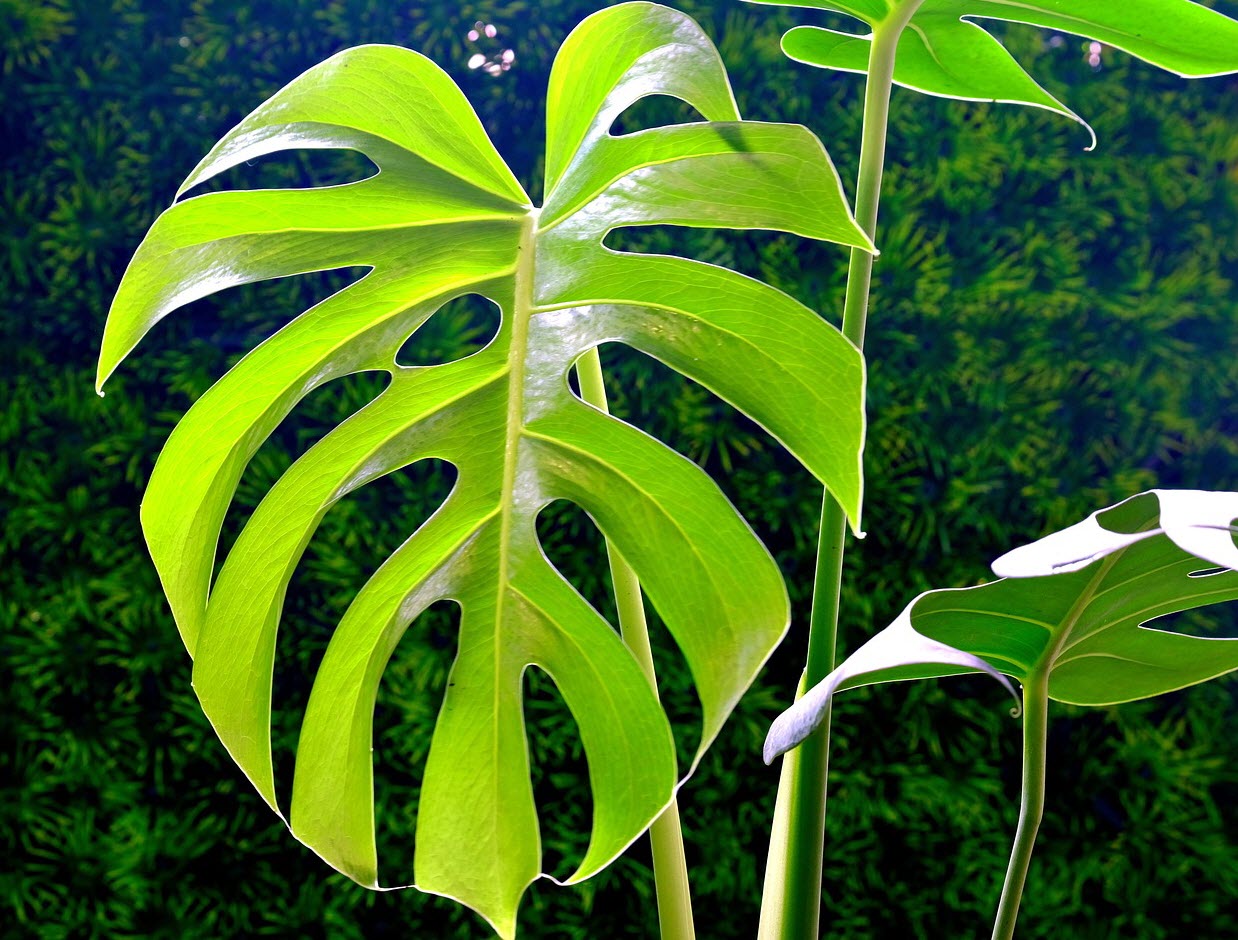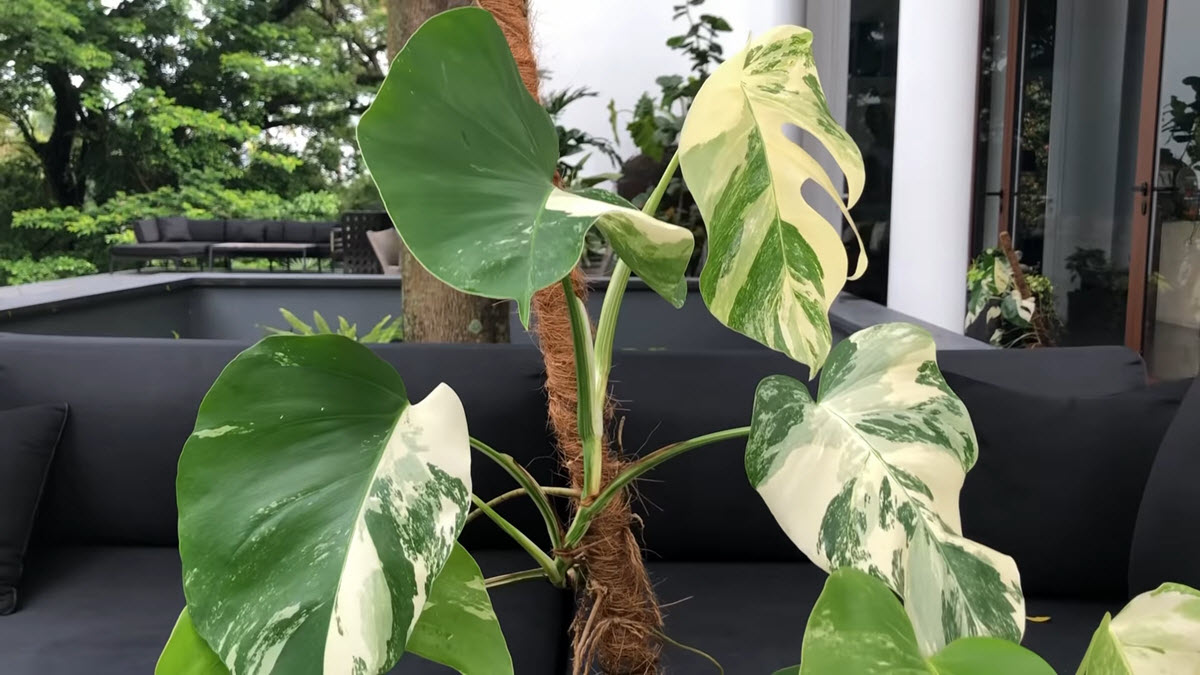Monstera deliciosa – Paludarium plants suitable for aquarium
It is relatively common that aquarium keepers grow Pothos above the water in their tank to create a natural look with natural foliage above the water and roots running down into the water to help keep the water clean and provide hiding places for the fish. There are plenty of other plants that you can use in the same way. One such plant is Monstera. Below you can read more about monstera and how to grow monstera in water.

Monstera is a genus of plants native to tropical regions of the Americas. The most commonly known species is Monstera deliciosa, also known as the Swiss cheese plant, which is popular for its unique foliage and ability to grow as an indoor plant.
The Swiss cheese plant has large, glossy, heart-shaped leaves with holes or splits in the leaves, which are said to resemble Swiss cheese. It is an easy-to-care-for plant that can grow up to 20 feet tall in ideal conditions. Monstera plants are known for their air-purifying properties, making them popular indoor plants. They require bright, indirect light and moist soil to thrive and should be watered regularly but not over-watered.
In addition to the Swiss cheese plant, there are several other species of Monstera plants, including Monstera adansonii, also known as the Swiss cheese vine, which has smaller, more delicate leaves with similar splits, and Monstera obliqua, which is a rare and highly sought-after plant with small, perforated leaves. Monstera obliqua is very hard to find for sale, and most plants advertised as Monstera obliqua is the much more common species Monstera obfuscata. Any true Monstera obfuscata will be sold at a very high price. Monstera obfuscata is very similar and is a cheaper and better alternative for most situation. Monstera obliqua is only suitable for dedicated collectors.
Overall, Monstera plants are popular for their unique foliage and easy-to-care-for nature, making them a popular choice for indoor plants and houseplant enthusiasts. Their easy-to-care-for nature also makes them perfect plants to grow in your aquarium.
Growing monstera in your aquarium
Monstera can be grown in water. caring for a monster in water is easy once the plant has been accustomed to growing in water. It is possible to root a monster cutting directly in your aquarium.
Here are the steps to grow Monstera in your aquarium:
From an adult plant
Choose a healthy Monstera plant with a few leaves and a healthy root system. Clean the roots well and place the plant so that the roots reach down into the water. It will take a few weeks for the plant to get used to growing in water. It is common for some roots to die during this process. This is nothing to worry about. The plant will grow new roots soon.
From a cutting:
Growing a monster from a cutting is easy. Cut a stem with a couple of leaves from the parent plant, making sure it has at least one node, which is the area where the leaf meets the stem. Two or three nodes is usually better. Place the stem so that the bottom of the stem is submerged in the water.
You can also let it root in a jar of water before placing it in the aquarium. To do this, you should fill a clear jar with clean water and place the stem in the jar. Make sure that the bottom of the stem is submerged in the water. Place the jar in a bright spot that receives indirect sunlight. Avoid direct sunlight, as it can damage the plant. Change the water in the jar every few days to ensure it stays clean and fresh. Rinse the roots with fresh water before placing them back in the jar. After a few weeks, you should start to see roots growing from the stem. Wait until the roots are at least a few inches long before transplanting the Monstera into your aquarium since there is a risk that you will damage the roots while transplanting the plant to the aquarium.
Variegated Monstera – Monster Deliousa “variegata”
Monstera variegata, also known as Variegated Monstera, is a rare and highly sought-after cultivar of the Monstera deliciosa plant. It is characterized by its unique foliage, which features green and white variegated leaves highly prized by houseplant enthusiasts.

The variegation is caused by a genetic mutation that causes the leaves to produce less chlorophyll, resulting in white or pale green patches on the leaves. The variegation can be irregular and vary from plant to plant, making each Variegated Monstera unique. There are several different types of variegated monstera.
Variegated Monstera requires similar care to its non-variegated counterpart, Monstera deliciosa. It thrives in bright, indirect light and well-draining soil that is kept moist but not waterlogged. It can be grown in your aquarium just like regular monstera.
It can be propagated by stem cuttings, which should be taken from a healthy, established plant and placed in water or soil until roots develop.
Due to its rarity and popularity, Variegated Monstera can be difficult to find and may be more expensive than other varieties of Monstera. However, for those who appreciate its unique and stunning foliage, it is worth the effort and cost to add it to their collection of houseplants. Small variegated Monstera often cost more than USD100. large plants or rare strains can cost a lot more.